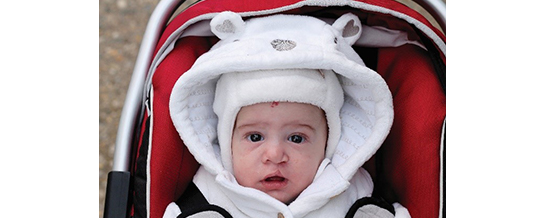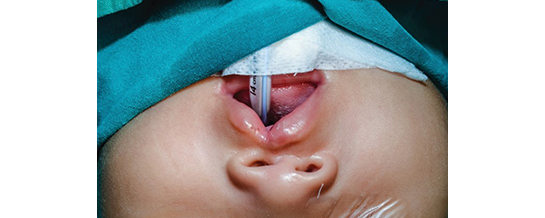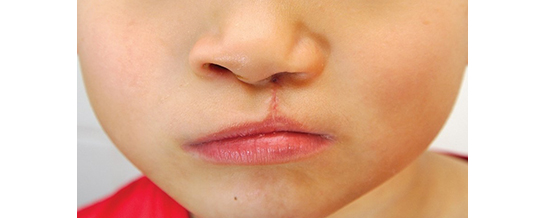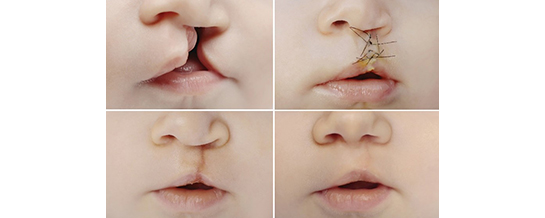Cleft Lip

What is a cleft lip?
A cleft lip is an opening or split in the upper lip. The split can be a small opening or a large opening that goes up towards the base of the nose. A cleft lip can occur on one side or both sides of the upper lip and is a somewhat common condition found in newborn babies.
A cleft lip can occur along with a cleft palate (openings or splits in the roof of the mouth) or without a cleft palate.
What causes a cleft lip?
A cleft lip is a birth defect occasionally found in newborn babies. The cleft occurs when the structures of an unborn baby’s face do not close completely while the baby is still in the womb. Most cleft lips develop with no known cause and are more common in families with other members already affected. About 1 in 1000 children is born with a cleft lip.
What are the symptoms?
Babies born with a cleft lip will not have any symptoms, and the cleft does not cause any discomfort for your baby. The only finding is a noticeable split or wide opening on the upper lip, and a nose that may look uneven or distorted.

How is it prevented?
Doctors does not know how to prevent a cleft lip from occurring. It is extremely rare that a cleft lip may be linked to a particular maternal exposure during pregnancy (for example: certain types of anti-seizure medicines, or folic acid deficiency). A cleft lip is almost never caused by anything that was done or not done by the parents or family during pregnancy.
How does cleft lip affect feeding?
Cleft lip without cleft palate does not have a major effect on feeding. Most babies with cleft lip without a cleft palate can breastfeed without a problem.
How is cleft lip repaired?
Babies born with a cleft lip will require surgery to close the opening in their lip. Your baby will be seen by the plastic surgeon in the hospital after he/she is born. The first doctor’s office visit will be scheduled for soon after birth. At your child’s first visit to the doctor’s office, the plastic surgeon will do a careful exam of your baby’s face and assess for any other medical problems. Pictures of the face are taken at this time with your consent for the medical record. If there is any concern with feeding, the doctor may ask the Occupational Therapist (OT) or Speech Language Pathologist (SLP) to be at your child’s first visit. The OT or SLP will perform a feeding assessment and offer guidance on how best to feed your baby. If needed, they will provide special cleft feeders to help assist with feeding. If possible, please bring with you to your appointment the bottle and milk/formula that your baby uses at home.

Surgery for cleft lip
Surgery is required to close a cleft lip because it will not close on its own. Your child’s surgeon will discuss with you the best time to schedule the procedure. Some children may need to see an Orthodontist before their procedure. This may cause the procedure to be moved to a later date. During the surgical repair, the doctor will gently release the tissues around the cleft in order to bring the cleft lip together with stitches and special skin glue. At the end of the procedure a small silicone stent (tube) may be placed into the nose and stitched in place. Stents are placed to help reshape the nose and will be removed at a follow up appointment at the doctor’s office. The procedure to close the cleft lip takes 1 to 2 hours, depending on the size and location of the opening. After surgery, your child’s surgeon will answer any questions you may have about the procedure.

Caring for your child after surgery
Most children go home 1- 2 days after surgery. The doctor will assess your child’s pain and ability to feed successfully before allowing them to go home. Do not touch the repaired cleft lip. It is very important that the repaired lip area be left alone during the first week after surgery.
You may gently pat off any milk/formula or fluid from the nose with a dry clean cloth. The doctor will do any necessary wound dressing changes at the post-surgery follow up appointment.

Managing Pain
You may give your child paracetamol or ibuprofen in the recommended dose as needed for pain.
Do not give your child aspirin as it may cause serious complications.
Diet
Will my child be able to eat after surgery?
Yes. Your healthcare care provider will be present immediately following the surgery to assist with post-surgery feeding. A number of alternative feeding methods will be considered to help reduce the possibility of injury to the newly repaired lip. There is not one feeding method that is best for all babies. Your healthcare care provider will work with you to determine the best method for your baby.
When to seek medical help:
If your child has any of the following symptoms, speak to your child’s health-care provider or go to the emergency department.
• A temperature of 38.5 degrees Celsius (100.4 degrees Fahrenheit) or higher
• Increased tenderness, redness, drainage or foul-smelling odor from the cleft lip area
• A large amount of swelling or bruising
Follow-up appointment
You will receive an appointment time to bring your child for a return visit five to seven days after surgery to check that the cleft lip is healing correctly. If you have any questions about preparing for surgery, details about the procedure, or the post-surgery recovery, please do not hesitate to ask your child’s doctor or nurse. They are always happy to answer your questions!

